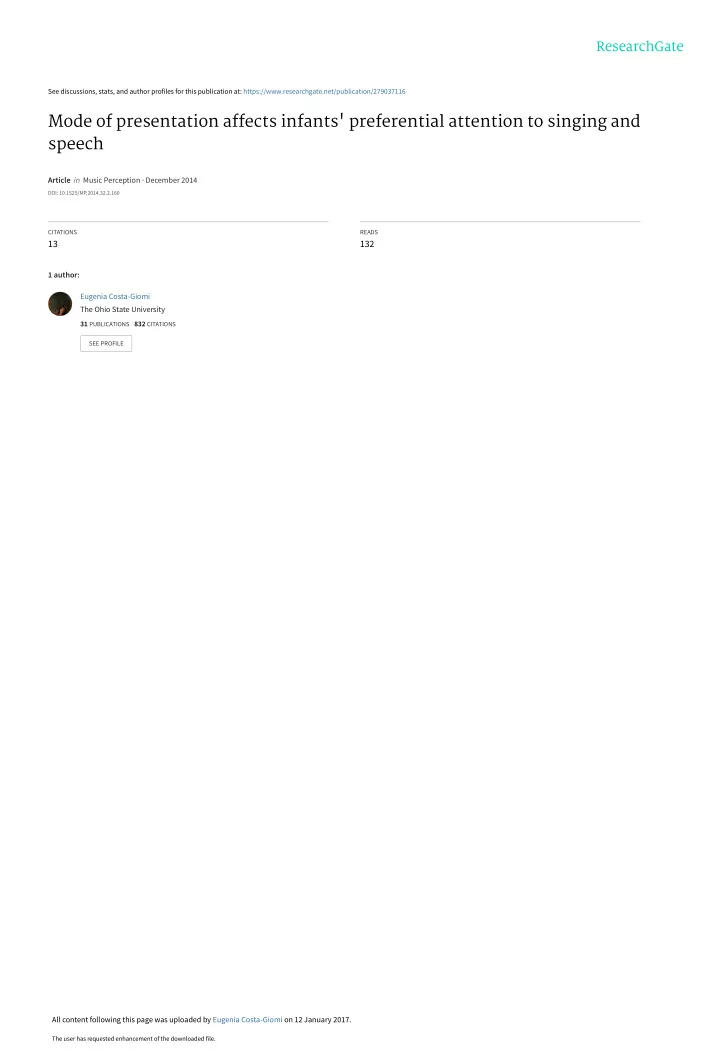

See discussions, stats, and author profiles for this publication at: https://www.researchgate.net/publication/279037116 Mode of presentation affects infants' preferential attention to singing and speech Article in Music Perception · December 2014 DOI: 10.1525/MP.2014.32.2.160 CITATIONS READS 13 132 1 author: Eugenia Costa-Giomi The Ohio State University 31 PUBLICATIONS 832 CITATIONS SEE PROFILE All content following this page was uploaded by Eugenia Costa-Giomi on 12 January 2017. The user has requested enhancement of the downloaded file.
Mode of Presentation Affects Infants’ Preferential Attention to Singing and Speech Author(s): Eugenia Costa-Giomi Source: Music Perception: An Interdisciplinary Journal, Vol. 32, No. 2 (December 2014), pp. 160-169 Published by: University of California Press Stable URL: http://www.jstor.org/stable/10.1525/mp.2014.32.2.160 . Accessed: 02/03/2015 18:24 Your use of the JSTOR archive indicates your acceptance of the Terms & Conditions of Use, available at . http://www.jstor.org/page/info/about/policies/terms.jsp . JSTOR is a not-for-profit service that helps scholars, researchers, and students discover, use, and build upon a wide range of content in a trusted digital archive. We use information technology and tools to increase productivity and facilitate new forms of scholarship. For more information about JSTOR, please contact support@jstor.org. . University of California Press is collaborating with JSTOR to digitize, preserve and extend access to Music Perception: An Interdisciplinary Journal. http://www.jstor.org This content downloaded from 128.83.63.180 on Mon, 2 Mar 2015 18:24:20 PM All use subject to JSTOR Terms and Conditions
160 Eugenia Costa-Giomi M ODE OF P RESENTATION A FFECTS I NFANTS ’ P REFERENTIAL A TTENTION TO S INGING AND S PEECH E UGENIA C OSTA -G IOMI infants to understand the content and structure of University of Texas – Austin music, they must learn to integrate and disassociate the multiple audiovisual cues of such diverse music A LMOST FROM BIRTH , INFANTS PREFER TO ATTEND experiences. to human vocalizations associated with speech over Research on infants’ music perception has focused many other sounds. However, studies that have focused almost exclusively on their ability to detect differences, on infants’ differential attention to speech and singing patterns, and similarities in music presented to them in have failed to show a speech listening bias. The purpose auditory mode and in the absence of visual cues. of the study was to investigate infants’ preferential Although many of the procedures used in infant attention to singing and speech presented in audiovisual research accompany the presentation of sound with and auditory mode. Using an infant-controlled prefer- an image, the image has no other value than directing ence procedure, 11-month-olds were presented with infants’ gaze and facilitating the measurement of atten- audiovisual stimuli depicting a woman singing or recit- tion to the auditory stimuli. Such approach has ing a song (Experiment 1, audiovisual condition). The increased our understanding of infants’ sensitivity to results showed that infants attended significantly longer a wide variety of music parameters but has provided to singing than to speech. In Experiment 2 (visual con- limited information as to how they integrate the visual dition), infants watched the same videos presented with and auditory information in which they are immersed no sound and in Experiment 3 (auditory condition), in daily life. they listened to the singing and speech stimuli in Visual information can distort the perception of audi- English and a foreign language. No differences in length tory stimuli. Studies on the McGurk effect illustrate this of attention to singing and speech were found in either phenomenon in a language context (e.g., McGurk & experiment. The results of the study reconcile the seem- MacDonald, 1976) and investigations completed with ingly contradicting findings of previous investigations music conductors (e.g., Morrison, Price, Geiger, & Cor- and show that mode of presentation affects infants’ nacchio, 2009) and performers (e.g., Juchniewicz, 2008) preferential attention to speech and singing. The facili- illustrate it in a music context. The findings of these and tating effects of facial cues on infants’ processing of other studies show that when presented with the same speech and singing are discussed. auditory information matched with different visual information, subjects often detect nonexistent differ- Received: July 19, 2013, accepted March 8, 2014. ences in sound. For example, Morrison et al. (2009) found that identical ensemble performances were rated Key words: auditory development, music, singing, as more or less expressive depending on whether they speech, multimodal perception were matched with videos of conductors displaying more or less expressive gestures. Infants do not seem immune to the influence of visual information on their I processing of auditory stimuli. The McGurk effect has NFANTS ARE IMMERSED IN SOUND EVEN BEFORE they are born. They are exposed to music, language, been found in infants as young as 5 months old and noises of all types almost every second of their (Rosemblum, Schmucker, & Johnson, 1997). lives. The sounds infants hear are produced in a variety Although visual information can create surprising auditory illusions, it can also aid in the understanding of ways. They hear music played by audio-only devices of auditory stimuli. This is true for adults trying to follow such as home stereos and portable music players and also by dynamic audiovisual sources such as interactive a conversation in a noisy environment (e.g., Ross, Saint- music toys, computers, and TVs. Sometimes they see Amour, Leavitt, Javitt, & Foxe, 2007), and for infants mom singing directly to them and sometimes they trying to decode the structure, content, and meaning of simply hear her singing in the next room. In order for speech. The facial movements that accompany speech Music Perception , VOLUME 32, ISSUE 2, PP . 160–169, ISSN 0730-7829, ELECTRONIC ISSN 1533-8312. 2014 BY THE REGENTS OF THE UNIVERSITY OF CALIFORNIA ALL RIGHTS RESERVED . PLEASE DIRECT ALL REQUESTS FOR PERMISSION TO PHOTOCOPY OR REPRODUCE ARTICLE CONTENT THROUGH THE UNIVERSITY OF CALIFORNIA PRESS ’ S RIGHTS AND PERMISSIONS WEBSITE , HTTP :// WWW . UCPRESSJOURNALS . COM / REPRINTINFO . ASP . DOI: 10.1525/ MP .2014.32.2.160 This content downloaded from 128.83.63.180 on Mon, 2 Mar 2015 18:24:20 PM All use subject to JSTOR Terms and Conditions
Recommend
More recommend